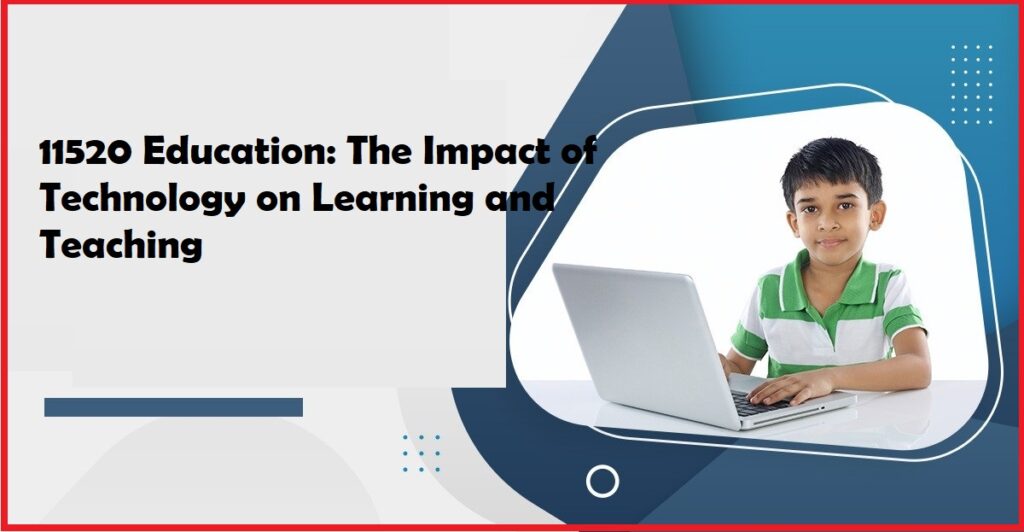11520 Education has been rapidly evolving, with technology being one of the major drivers of change. The integration of technology in 11520 Education has transformed the way we learn and teach, making education more accessible, interactive, and engaging. In this article, we will delve into the impact of technology on education and explore how it has revolutionized the learning process.
11520 Education Learning and Teaching
Introduction – 11520 Education
Technology has permeated almost every aspect of our lives, and 11520 Education is no exception. With the rise of digital transformation, education has undergone a significant shift, moving away from traditional teaching methods to more interactive and innovative approaches. The integration of technology in education has revolutionized the learning process, making it more accessible, interactive, and engaging.
The Digital Transformation of 11520 Education
Digital transformation in education refers to the integration of technology into the learning process, including digital tools and platforms that enhance the teaching and learning experience. Here are some examples of how technology is transforming education: What Is A Cross-Sectional Study in UK 2023
Digital Learning 11520 Education
Digital learning refers to the use of digital technologies to facilitate learning. Digital learning can take many forms, including online courses, webinars, and interactive educational software.
Gamification of Learning
Gamification of learning involves using game-like elements to promote learning, engagement, and motivation. This approach can include quizzes, challenges, and rewards to enhance the learning experience. 11520 Education

Personalized Learning
Personalized learning involves tailoring the learning experience to meet the individual needs of each student. Technology can be used to create personalized learning paths, assessments, and feedback.
Blended Learning
Blended learning is a combination of online and traditional learning methods. This approach allows for flexibility in the learning process and can enhance the overall learning experience.
Educational Technology Tools – 11520 Education
The use of technology in education has led to the development of various educational technology tools that can enhance the teaching and learning process. Some examples include: Study In Australia For Indian Students Information 2023
Learning Management Systems (LMS)
LMS platforms are used to manage and deliver educational content, assessments, and feedback. These platforms can also track student progress and provide analytics to improve the learning experience.
Online Learning Platforms
Online learning platforms, such as Coursera, Udemy, and edX, offer a wide range of online courses and certifications. 11520 Education These platforms can be accessed from anywhere and offer flexibility in the learning process.
Virtual Reality (VR) and Augmented Reality (AR)
VR and AR technologies can be used to create immersive learning experiences, such as virtual field trips, simulations, and interactive experiments.
Artificial Intelligence (AI) and Machine Learning (ML)
AI and ML technologies have the potential to transform 11520 Education by providing personalized learning experiences, automating administrative tasks, and enhancing the overall learning experience. These technologies can be used to analyze student data, identify learning patterns, and provide personalized recommendations to students.
Advantages of Technology in Education
The integration of technology in 11520 Education has numerous advantages, including:
Increased Access to Education
Technology has made education more accessible by providing online courses, virtual classrooms, and distance learning options. This has opened up new opportunities for students who may not have had access to education otherwise.
Enhances Student Engagement
Technology can enhance student engagement by providing interactive and immersive learning experiences. Gamification of learning, VR and AR technologies, and personalized learning paths can all contribute to increased student engagement.
Facilitates Personalized Learning
Technology can facilitate personalized learning by providing customized learning paths, assessments, and feedback based on individual student needs. This can help students learn at their own pace and achieve their learning goals.
Improves Collaboration and Communication
Technology can also improve collaboration and communication in education by providing tools for real-time communication, file sharing, and collaborative workspaces. This can help students work together on group projects and facilitate communication between educators and students.
Challenges of Technology in Education
While the integration of technology in education has many advantages, it also comes with some challenges, including:
Technological and Infrastructural Barriers
Access to technology and infrastructure can be a barrier to the adoption of educational technology. Not all schools or students have access to the necessary technology or internet connection required for digital learning.
Lack of Technological Training for Educators
Educators may lack the necessary training to effectively integrate technology into their teaching methods. This can lead to a lack of confidence in using technology or inefficient use of technology in the classroom.
Cybersecurity Risks
The use of technology in education can also present cybersecurity risks, such as data breaches or hacking. Schools and educators must take steps to ensure that student data is protected and that cybersecurity measures are in place.
Conclusion – 11520 Education
Technology has revolutionized education, making it more accessible, interactive, and engaging. The integration of technology in education has numerous advantages, including increased access to education, enhanced student engagement, facilitated personalized learning, and improved collaboration and communication.
However, there are also challenges associated with the adoption of educational technology, such as technological barriers, lack of training for educators, and cybersecurity risks. Educators and schools must take steps to ensure that technology is used effectively and safely in the classroom.
FAQs
What are some common examples of educational technology tools?
Some common examples of educational technology tools include Learning Management Systems (LMS), online learning platforms, virtual reality (VR) and augmented reality (AR) technologies, and artificial intelligence (AI) and machine learning (ML) tools.
How can technology help personalize learning for students?
Technology can help personalize learning for students by providing customized learning paths, assessments, and feedback based on individual student needs.
How can technology be used to promote collaboration and communication in education?
Technology can be used to promote collaboration and communication in education by providing tools for real-time communication, file sharing, and collaborative workspaces.
What are some of the challenges associated with technology in education?
Some challenges associated with technology in education include technological and infrastructural barriers, lack of technological training for educators, and cybersecurity risks.
